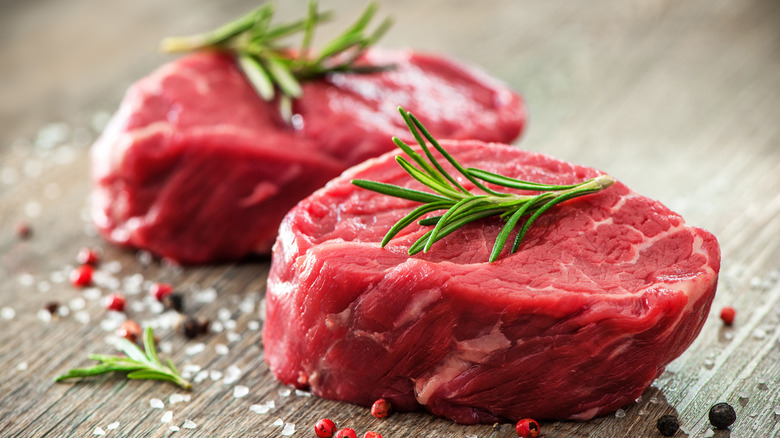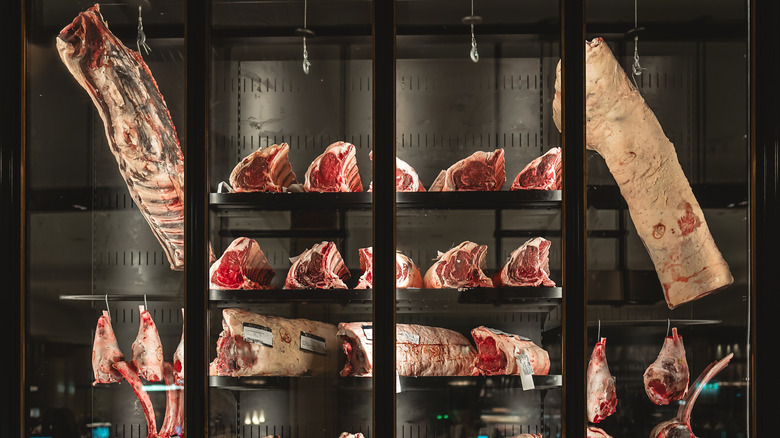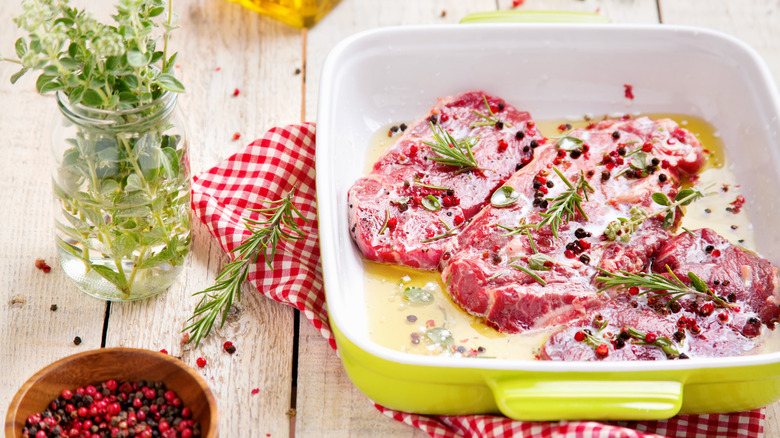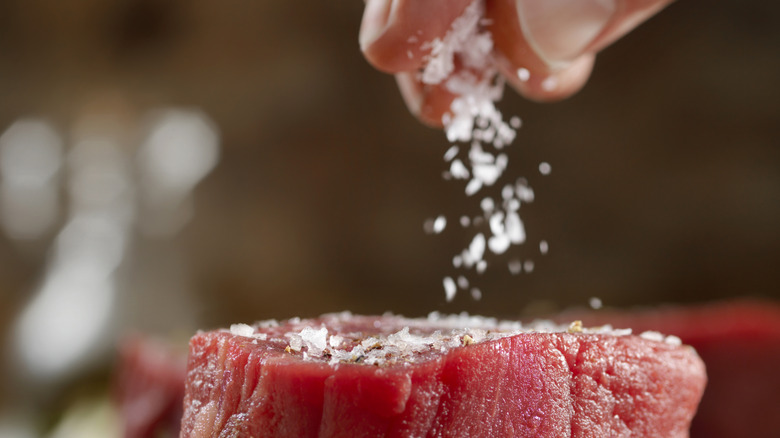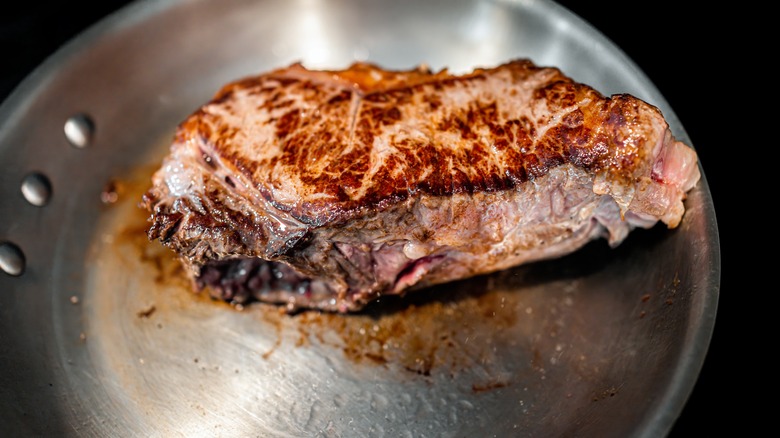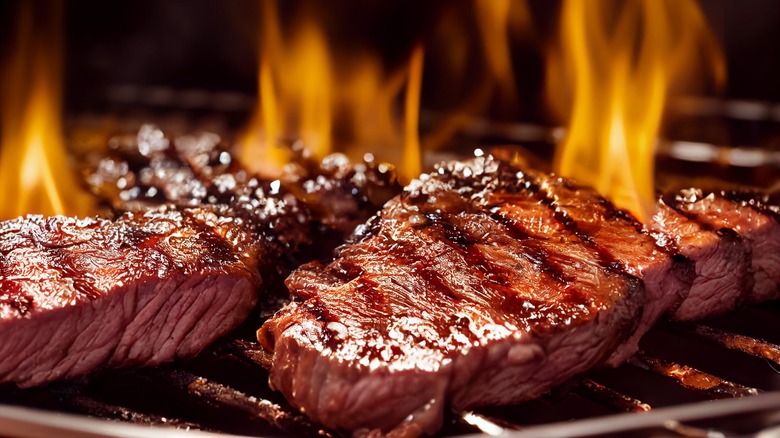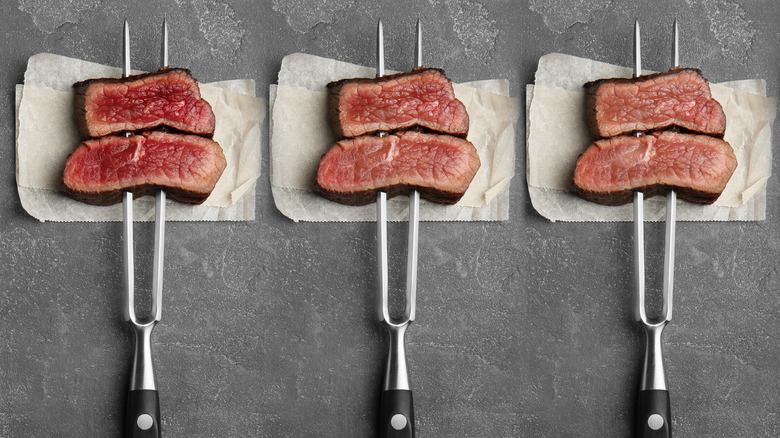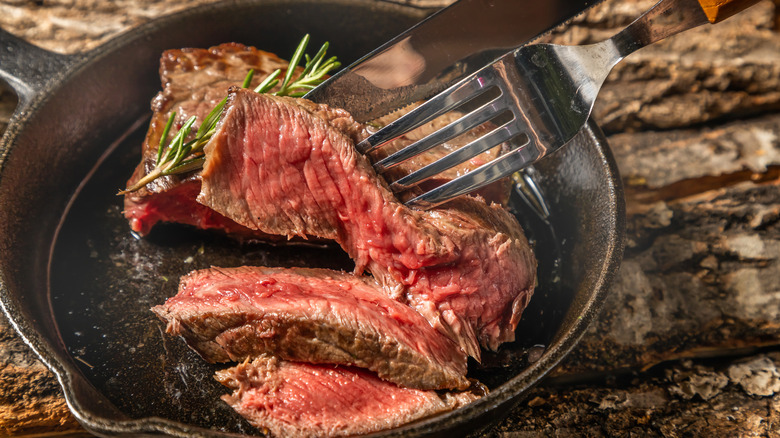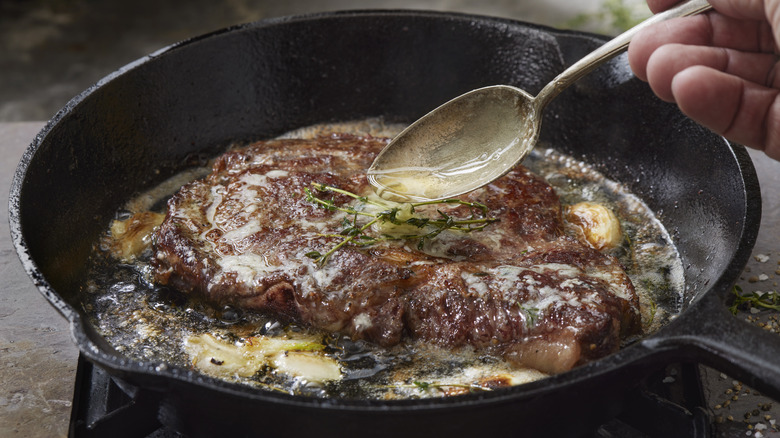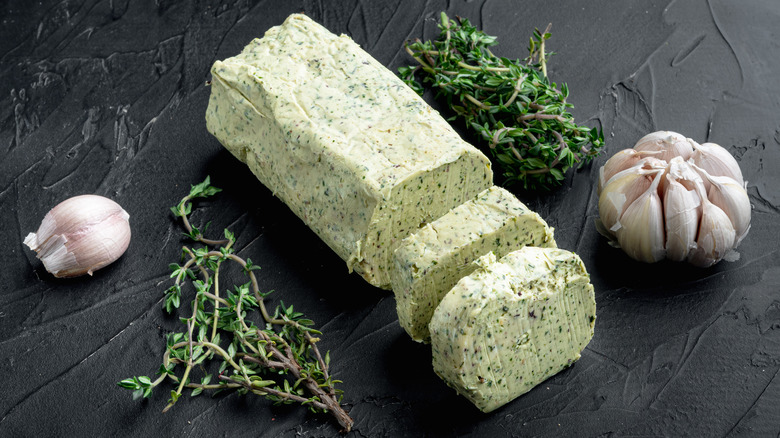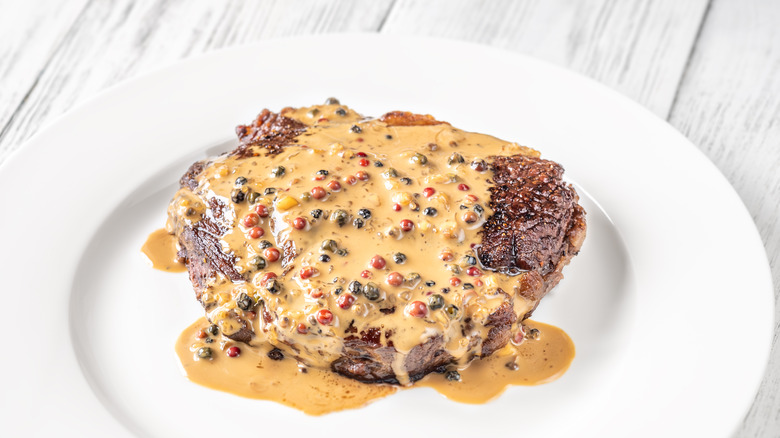Chefs Reveal The Secrets Steakhouses Use To Add Flavor To Lean Cuts Of Meat
The flavor bombs of the beef world tend to be the fattier ones: Think ribeye with its luscious fat cap or well-marbled tomahawk. But there's certainly room at the table for leaner cuts, which Katie Flannery of Flannery Beef says "can be a good option for anyone who follows a low fat diet," and Michael Paley, Executive Chef of Prime 54 at Fontainebleau Miami Beach, attributes with other health benefits, like a richness in zinc and iron. Josh Copeland, Owner of Camino Alto in San Francisco, notes that leaner cuts are also more wholesome, "considering the diet of 97% of steers used for beef." Corn-fed beef tends to be higher in omega-6 fatty acids, while grass-fed beef is richer in omega-3s, a discrepancy he says means, "You may want to be selective with your fattier cuts."
Health is only one part of the puzzle, however. What lean cuts lack in flavor they often make up in tenderness, according to Chef Ian Beggs from Absinthe Brasserie & Bar in San Francisco, who points to filet mignon as the perfect example.
But while these steaks can certainly use some help in the flavor department, Beggs denounces maximalist methods. "I shudder when I see people inject meat with a syringe or stuff cloves of garlic into meat after jabbing it with a knife," he says. "These methods create exit pathways for all of the wonderful juice you should be trying to keep in the meat." Instead, opt for one of these chef-approved methods.
Dry-age your lean steak at home
Dry aging is all the rage these days, and it's not hard to see why. "Dry aging can help enhance the flavor of leaner cuts, as it allows moisture to evaporate from the muscle, concentrating the natural flavor of the meat," explains Katie Flannery. The resulting steaks, according to Sean Olnowich, Executive Chef of Bounce Delray Beach, have a more intense, beefier flavor. And while many butcher shops sell dry-aged steaks, some enterprising home cooks have begun attempting at-home dry aging too.
If you do decide to try your hand at it, our chefs counsel prudence. "If not done properly, bacteria levels can get out of control and be unsafe to eat," says Chef Bobby Will, chef/owner of Thistle & Grouse in Portland, Maine. "I recommend novice steak cookers find a reputable butcher to buy dry aged leaner meats."
And contamination is just one reason some chefs steer clear of attempting this technique with leaner cuts. According to Michael Paley, while you may intensify the flavor of your lean cuts through dry aging, "The problem with dry aging lean cuts is that there is no intramuscular fat to make up for the moisture loss during the dry age process." Matt Kreider, Executive Chef of Steak 954, agrees, noting that, "The flavor from dry aging typically melds with fats a bit better." The result, according to Paley, may mean a dry steak ... so be sure to proceed with caution.
Marinate your steak in a flavorful marinade
Marinating is a great way to impart flavor to leaner cuts of steak, according to Matt Kreider, who notes that a marinade can "protect" a lean cut, preserving its moisture and texture — especially when it features a healthy dose of acid. "The acid will start to 'cook' the meat so there's less chance of a dry finished product," explains Josh Copeland. As for which acid to use, Katie Flannery cites a bevy of options, including lemon juice, buttermilk, low-pH fruits, wine, cola, and vinegar. These ingredients, she says, "break down sinew and fiber." Another great base ingredient, according to Sean Olnowich, is soy sauce, which imparts loads of umami and salt, both of which, he says, "can greatly enhance a lean cut."
A word of warning: More isn't always better when it comes to marinades. "An acidic marinade can cook the steak if you leave it in too long," explains Bobby Will. "A marinade heavy on sugar can caramelize the steak faster and possibly burn the sugars." He recommends an hour max of marinating; Flannery suggests you could go a bit longer — a few hours for a thinner cut like flank or up to overnight for a thicker top sirloin. Other than that, it's hard to go wrong with a marinade ... with one exception. "I am not a fan of the root beer and Italian dressing marinade," says Will. "I get it is trendy, I believe that we can leave in the past."
Season lean steaks generously
Seeing as leaner steaks lack the fatty flavor that make more marbled steaks pop, it's important to season them fairly generously. Salt is, of course, a given: Bobby Will seasons his steaks "really well" (emphasis his) an hour or even two hours before cooking. This, he says, can "gently cure the steak," improving its texture and suffusing it with even more flavor.
But salt isn't your only option. "A nice blackening spice or togarashi spice crust before searing can go a long way to make a boring steak more interesting," says Will. Sean Olnowich also suggests pastrami spice or Cajun spice blends to enhance the flavor of lean cuts and add more interesting aromas to the party.
That said, Katie Flannery cautions against going overboard with spice blends such as these. "It can be tempting to go heavy with your seasoning when working with a leaner cut," she says, "but avoid over seasoning, as it can quickly overpower the natural steak flavor."
Sear lean steaks hard
The cooking method you use for a leaner cut of steak is crucial in giving it as much flavor as possible — and for Sean Olnowich, "Leaner cuts are not open to all of the cooking methods that fattier cuts can use." Pretty much any low-heat method is unlikely to set your steak to its best advantage. "You would not want to braise a filet mignon," he says.
Instead, he recommends quickly searing lean steaks over a high heat to caramelize the outer layer, which he says will impart "sweet and savory char notes on the steak" thanks to the power of the Maillard reaction. "Searing leaner meats at high temperatures caramelizes the flesh and creates more flavor," echoes Ian Beggs.
To take advantage of this tip, start with a heavy-duty pan and a cooking fat with a high smoke point. "I prefer high heat on a cast iron pan, with grapeseed oil," says Bobby Will. "Hard sear on both sides." The resulting steak will wow you with its deep flavor.
Cook lean steaks over a flame
Cooking lean steaks on the barbecue is a great idea for more than one reason. Not only does a live fire give you just as much ripping heat as hot cast iron, but it also adds a smoky quality to the steak, which means even more flavor. "A nice charcoal for the grill is always a superstar," says Matt Kreider. Sean Olnowich also loves grilling, "preferably over hardwood charcoal," noting that "the smokey, hard char flavor you get off of a grill for a steak is unmatched."
Ian Beggs agrees, citing his preference for either wood or charcoal grilling rather than gas. This cooking method, he says, also gives you the opportunity to add other aromatics to the mix. He loves to add rosemary directly to the fire near the end of cooking, closing the lid of the grill to infuse the steaks with even more aromatic potential.
Cook lean steaks no more than medium
Most people usually don't like well-done steaks, and while this may be a case of to each his own, lean steaks are particularly tasty when they still have a bit of pink color. "When cooking lean cuts, it becomes very important not to overcook the steak," says Michael Paley, who notes that a well-done lean steak suffers significantly when it comes to its texture. "Cooking the meat too well will make the steak way too chewy to enjoy," he says, "and all the flavor is lost."
Katie Flannery and Sean Olnowich agree, both noting that medium-rare is the ideal cuisson for leaner steaks. "They will get exponentially more tough when you go towards medium/well done," says Flannery. Bobby Will agrees, noting that lean cuts are "less forgiving" than fattier ones of overcooking. He prefers to cook his lean steaks to rare, allowing them to carry-over cook to the perfect medium-rare during the resting period. This ensures a juicy, tender steak every time.
Finish lean steaks with butter
Cooking steak in fat is a no-brainer, but while butter may seem like the most flavorful choice, it's far from the ideal cooking fat. Achieving a beautifully browned crust requires high heat, and butter's smoke point is relatively low — about 350 degrees Fahrenheit. "Butter will burn before the steak is finished if you start straight out the gate," says Bobby Will, who notes that butter should never be your starting fat, "unless you like the taste of carbon with your steak."
He starts steaks with grapeseed oil, which boasts a smoke point of 420 degrees Fahrenheit; Ian Beggs prefers beef tallow, which also only burns at around 420 degrees Fahrenheit. They only add butter as a flavorful finishing touch. "We'll start the steak on the grill and finish in a shallow pan of clarified butter, turning once," says Josh Copeland. "We use clarified butter so we can heat to a higher temperature and to diminish the butter flavor just enough to show off the steak flavor."
He also sometimes adds whole butter off the heat, as does Matt Kreider. "I love finishing lean cuts with a little bit of brown butter," he says. "It can add a nuttiness and sweetness, as well as tons of flavor." Michael Paley does note that finishing with butter may offset the health benefits of having chosen a lean cut in the first place, so take this into consideration when deciding whether you want to add butter to lean steak.
Baste lean steaks as they cook
Butter can be added to a steak in many ways, but perhaps the most common technique for restaurant chefs is basting, which Katie Flannery says, "will give you a beautifully browned crust." And what's more, the butter can be seasoned with aromatics like herbs and garlic to add even more flavor to the steak. "The benefit of adding aromatics to the butter is that once you've finished cooking, you can drizzle the aromatic butter sauce on the sliced steak for an even tastier end result," she says.
Michael Paley suggests cooking your steak to about 85% of your desired doneness before adding cold butter, garlic cloves, and herbs like thyme to the pan. As the butter melts, Sean Olnowich adds, the milk solids will caramelize, imparting nutty notes to the steak and the fat itself. At this point, he suggests, "slightly lean the pan in your direction, and with a sauce spoon, scoop the brown butter and carefully turn it onto the top of the steak several times to baste the top." Matt Kreider likes to do this "vigorously" for "at least a good minute" to ensure the meat picks up on all of those lovely flavors.
Top steaks with compound butter
If you're looking for a quick and easy way to add loads of flavor to lean steaks, consider making a compound butter ahead of time. Sean Olnowich loves combining butter with alliums like shallots or garlic and herbs like tarragon, marjoram, chives, or cilantro, as well as some crunchy Maldon salt to add just the right amount of texture and flavor. Michael Paley adds luxe appeal with truffle or caviar and as freshness with citrus, while Bobby Will adds sweet roasted garlic and "a splash of tamari to zest it up." Whatever ingredients you choose can be whipped together in the food processor before rolling the butter into a log with help from a sheet of parchment paper or plastic wrap and chilled until firm.
"When the steak has rested after cooking and ready to serve," explains Olnowich, "I cut a disc of the compound butter and place it on top. The heat on the steak will slightly soften the chilled butter, but it is also a good idea to flash the steak under a broiler for 30 seconds to soften it to a point of spreading over the steak." Katie Flannery even makes a quick, last-minute compound butter by quickly incorporating a tablespoon of miso and half a stick of room temperature butter. "Drop a dollop on your steak as you plate," she says. "Easy peasy!"
Add a homemade sauce to your steak
Another great way to add flavor to lean cuts of steak is with a sauce, something Ian Beggs notes "is always recommended to add layers of flavor and complexity to your dish." And the choices are endless — and varied. "There's a huge middle ground between grabbing the A1 from your fridge, and putting the hours in to make a French bearnaise," says Katie Flannery.
Herby chimichurri comes together quickly, while more time-intensive choices may include Beggs' bordelaise, a red wine sauce that begins with a veal stock that simmers for several days. Au poivre is a classic choice for filet mignon, laced generously with black pepper and cream, and Josh Copeland is a big fan of mojo de ajo, a Mexican garlic-based sauce. Bobby Will loves making a pan sauce while the steak is resting, deglazing the pan with a full-bodied red and reducing it before adding beef broth and mounting the finished sauce with cold butter and a bit of lemon juice for acidity.
While it's hard to go wrong with sauces, there are a few things to steer clear of. "Using thick cloying sauces is a no no for me," says Sean Olnowich. "Leaner cuts don't have the thick fatty richness to stand up to a thick sauce." Matt Kreider also recommends being judicious with sauce application. "Buy nice beef and let it shine," he says. "You didn't buy a nice steak to only taste a sauce."
Use the steak as an ingredient
Steak and potatoes are a classic pair for a reason, but opting for a leaner cut is actually a great opportunity to get a bit cheffier with things to add even more flavor and moisture to the dish. It's for this reason that Katie Flannery sees lean steaks as "great opportunities to make dishes that go beyond your typical 'steak on a plate.'" As for what this means, the only limits are your imagination.
Flannery suggests using lean steak as the base of a stir fry, the topping for a pile of nachos, or a flavorful taco filling. Steak fajitas are phenomenal, and grilled slices of flank steak also make a lovely topping for a salad. Josh Copeland loves wrapping leaner steaks in dough, a technique that ensures it will retain all of its moisture and texture. (Think beef Wellington.) And these suggestions are only scratching the surface of all the ways to allow these cuts to shine alongside some wonderful supporting players.
